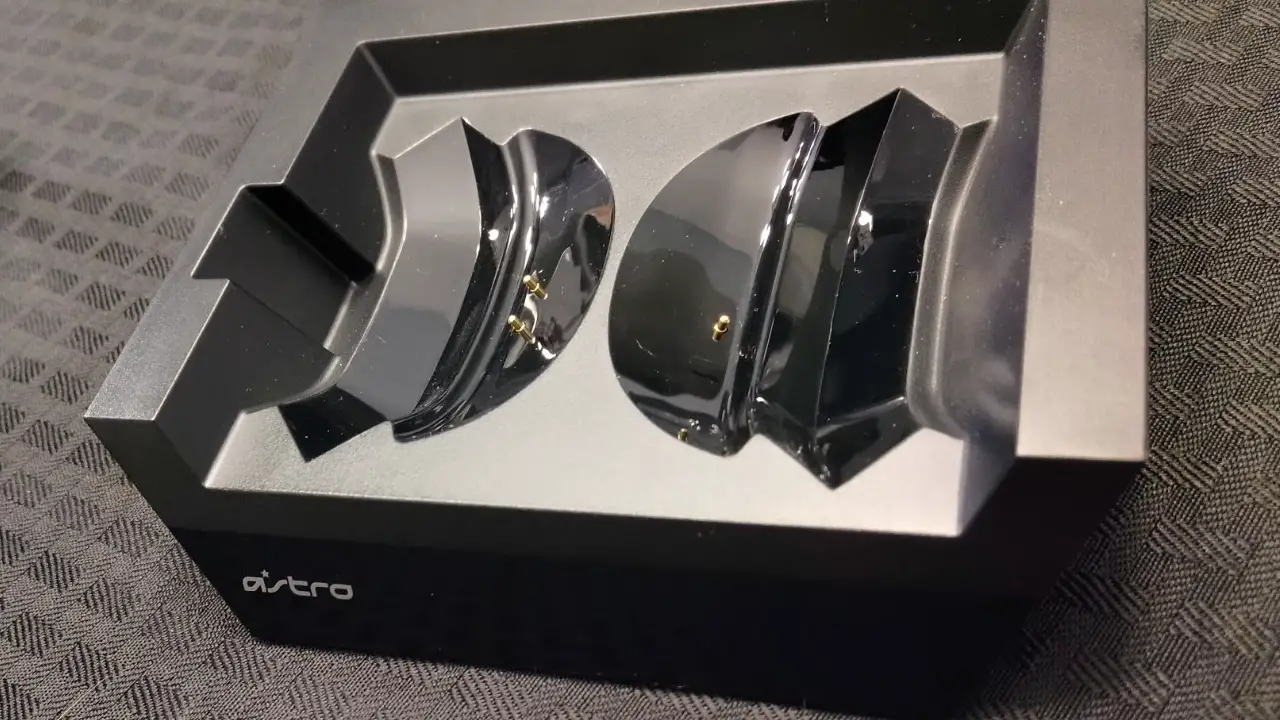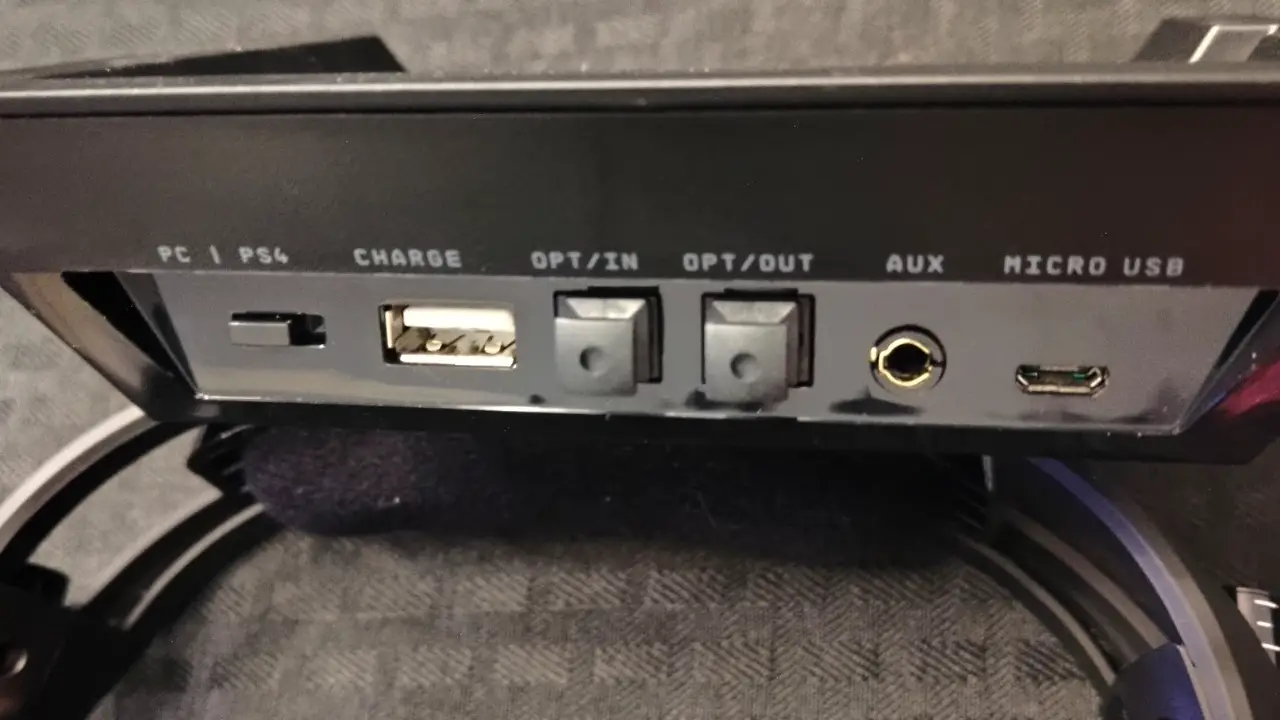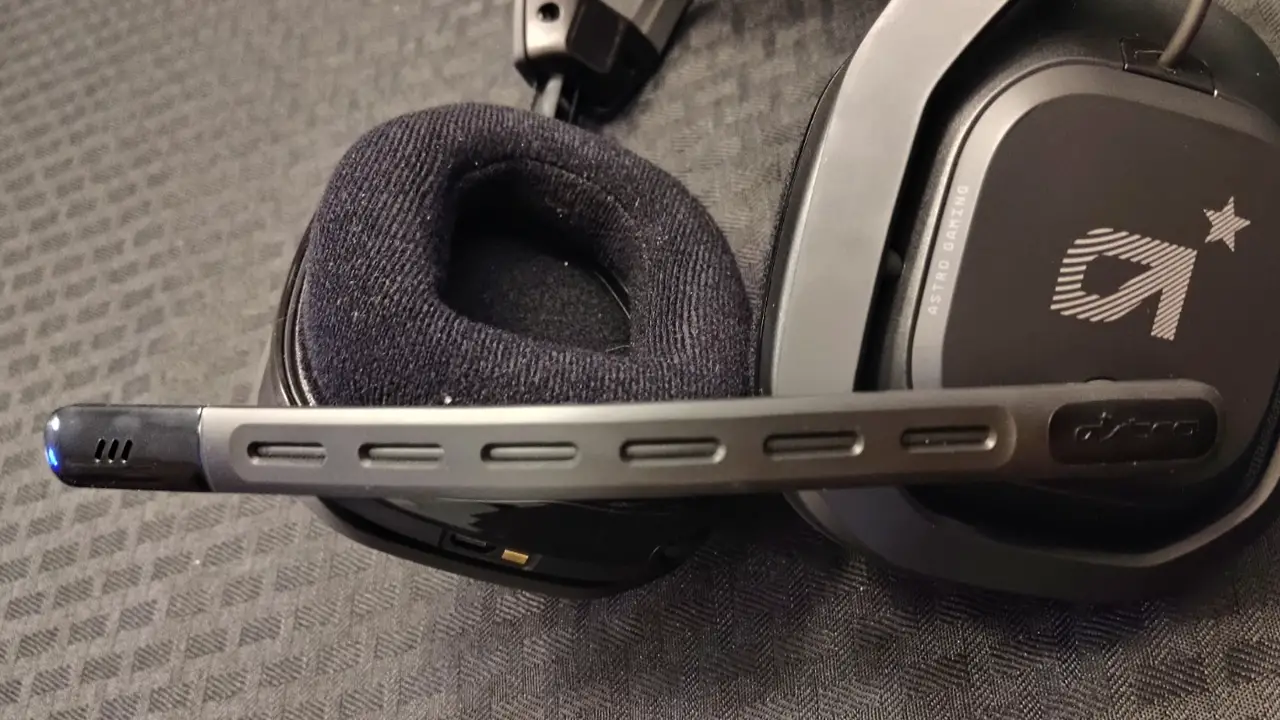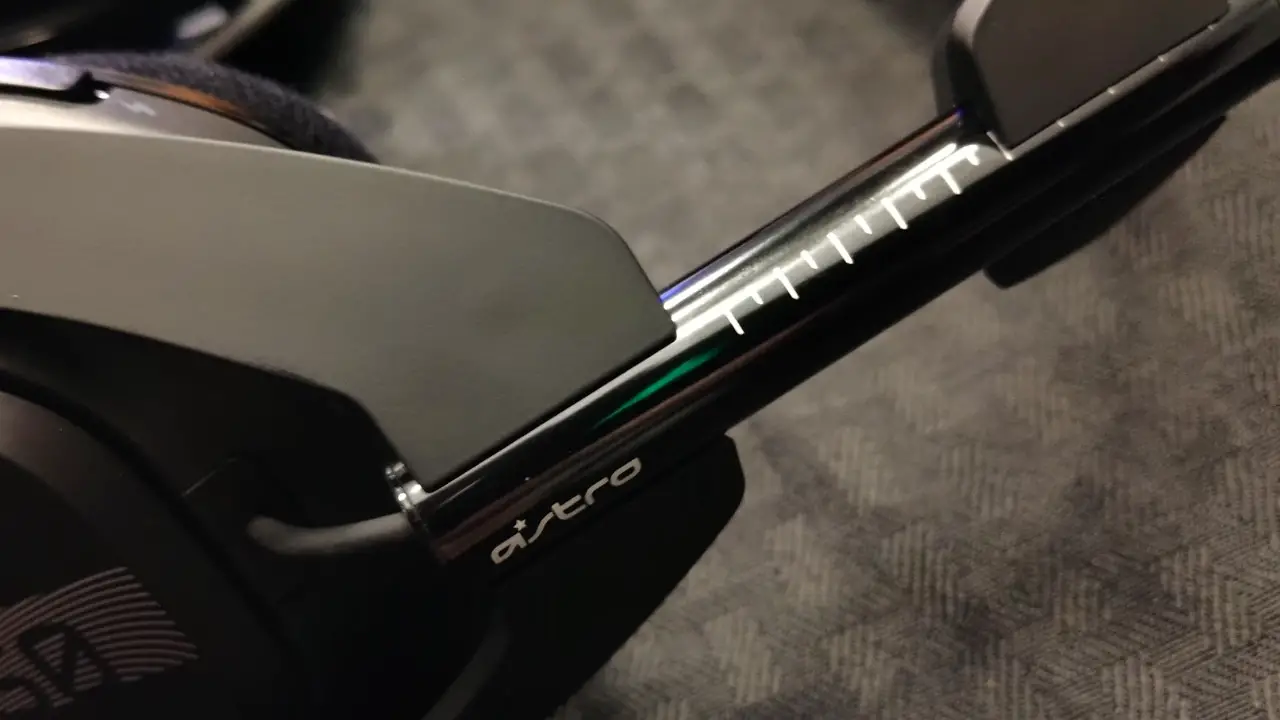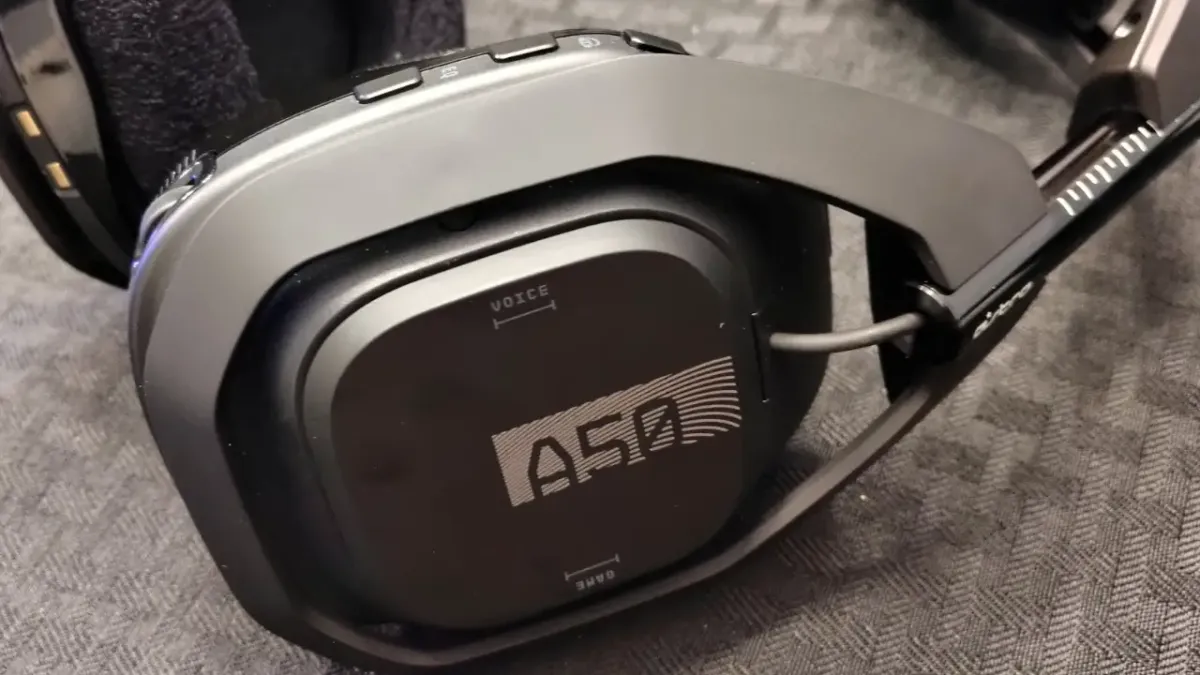
There is a constant tug of war in the headset world between weight, build construction, sound quality, and price. Listening to fan feedback, Astro Gaming has updated their A50 Wireless Headset line to a fourth iteration. Still called the A50, this newest version features an upgraded charging cradle, some feature updates, mod support, and a new price (sort of). Let’s break these open and see what’s inside.
After roughly four hours of initial charging, the A50s were ready to use, so it seems fitting to start digging in with the new base unit. Gone is the makeshift banana stand replaced by a wireless charging base that, shockingly, never seems to allow the headphones to fall off. On the bottom of the left earcup of the A50 is a pair of contact pads, with a single pad on the right. When they stand on the charger, they stand upright, sitting in two detents on the base. There’s no need for plugging in wires (though there is a micro-USB, should you need a bit more juice, or want to take it on the go without carting around the stand), and the base display on the face of it shows charge level, whether Dolby is enabled, and which device is currently connected. It would be great to see that micro-USB charge port swapped for USB-C and Quickcharge 2.0 as that is the industry direction, but we’ll have to hold that thought for V5 it seems.
Speaking of the “device currently connected”, the Astro A50 comes in two packages — one for PC and PS4, and another that covers PC and Xbox One. Unfortunately, the way that Microsoft and Sony have approached audio and connectivity leaves a lot of peripheral manufacturers having to scramble to serve a market where gamers might own both consoles and a PC. Unfortunately, there isn’t an elegant solution here, meaning the only way to get all three devices rolling with the A50s is to buy a second base station for an additional $79.99. This isn’t an unfamiliar problem, but it’s annoying that there isn’t an elegant solution.
The base station for this generation of the A50 has gotten a bit of an update. While the Gen 3 was a little plain, all sorts of visual indicators have been added to this new edition. There is now a four stage power indicator with an audible notification at 10% and 5% as well. Next to those lights are two platform indicators that indicate whether the device is currently paired to your PS4 or PC (or Xbox, if you have that version). Adjacent is a Dolby symbol and a star, with the former being illuminated when Dolby is enabled, and the star indicating when the A50 is simply in audio pass-through mode. The last visual indicator on the charge dock is the numbers 1, 2, and 3, showing you at a glance which EQ mode you currently have selected.
Moving around the headset, Astro has leaned into a mixture of radial dials and physical switches for their controls. Rather than the usual “hold to start” button, Astro has gone with a much-preferred toggle switch to power them up. It even has a small LED to let you know that the A50 is on, and it blinks when the device is charging — no guesswork here. Moving down the right ear cup, the next button enables the magic — it turns on the Dolby Pro Logic IIx support, providing a crisp and clean simulated 7.1 surround sound right to your dome. The last button on the rear edge of the right ear cup is the Equalizer toggle. This button moves between the three built-in EQ presets, with one, two, or three beeps to differentiate between them. Astro defines them as Media (higher bass levels), Core (balanced for single player gaming), or Pro (boosted highs for competitive play). Depending on the type of game, hearing the footfalls of your enemies may be more or less important, so I found myself bouncing between the second and third settings pretty frequently. We’ll dig into the EQ a bit more later, so put a pin in that thought.
Audio mix beyond the EQ is handled three ways on the Astro A50. There is a large radial dial with small detents to handle the master audio duties, but the mixture of audio to voice is handled by pressing on the outside face of the right ear cup. Pressing on the front of the right ear cup pushes the audio balance towards “game”, and tapping the back pushes the audio balance back towards the “voice”. Since these are not handled as two discrete audio sources, pushing up the game audio reduces voice, and visa versa. Astro does sell the MixAmp Pro TR ($79.99) to divvy up those audio channels and control them in a more granular fashion, but without that, it’s similar to what we’ve seen in other wireless headphones. Still — for a $299 price point, I’d have preferred a discrete audio channel.
Speaking of the price point, the Gen 3 A50s debuted at $299, as does the Gen 4 versions, but that doesn’t quite tell the whole story. The Gen 3 headphones shipped with a folding stand that didn’t charge them, didn’t contain a USB charging or optical cable, and the base station was additional. This new version of the A50 comes with all of the above, effectively cutting the price by $79.99 — the cost of the base station.
While high quality is also accompanied by a higher price tag, I do have one big complaint with the Astro line of headsets in general — a one year warranty. While there’s nothing you can do about that with Astro, I would recommend a 3-year $59.99 SquareTrade warranty to further protect your investment.
The microphone on the A50 is a flexible 6mm uni-directional voice isolating arm that extends all the way to the corner of my mouth, able to pick up voice chat easily. You can swing the arm almost perpendicular to the body of the unit, but closer is better. Finding the sweet spot is going to be different for everyone, and this bendable arm achieves that nicely. My only real complaint is that I can’t remove it — unlike the Astro A40, the microphone is permanently attached. Since it is permanently attached, however, swinging it to the vertical position mutes it. There’s even a nice detent for the mic to snap into, letting you know that you should be free to cough, crunch those chips, or whatever else you might be doing while waiting for your next round.
Digging into the software elements of the A50 isn’t truly necessary beyond loading new firmware, but if you are in any way serious about your audio quality, I highly recommend it. While the three prebuilt EQ settings work well enough, inside of the Astro Command Center lies all of the levers and buttons you could ever want to push to adjust those three settings into something that serves your needs precisely. There are multiple settings for microphone pickup levels, multiple preset options as well as the ability to load any you download, as well as granular adjustment from 40hz to 11,000hz for the center channel, as well as the bandwidth levels within each band. I’m ¾ deaf so I assure you that my needs differ from yours, but having the ability to make this level adjustment easily is a godsend.
Looking at the overall fit of the A50, I absolutely love the adjustment system. The main arms of the headphones are aluminum with each notch being roughly a millimeter and a half distance between. The ear cups slide on these arms, holding in place wherever you place them through mechanical friction. I was worried about this when I first started using it, expecting that it would start to lose its grip, but after a month of use I don’t see any signs of slipping.
In terms of overall comfort, let’s first talk about weight. Gathering a few headphones from multiple manufacturers, in order of weight we have the Elite Atlas at 13.3oz, the Astro A50 weighing 12.7oz, Recon Spark at a svelte 8.7oz, and finally the Rig 700 HD at just 8.5oz. For comparison, an Xbox One controller weighs 9.9oz. While this does place it near the top end of the weight scale, it’s important to point out that the only arguable comparator in this list is the heavier Elite Atlas.
The Astro A50 sits comfortably on the head, and over hours of use I didn’t feel pressure on my ear helix — a common problem among heavier headsets. The Astro A50 ships with cloth ear cups and headband, which are a matter of comfort and preference. There is a pair of $39.99 “mod kits” that provide pleather versions of the same, but that feels like a steep upgrade for something that is generally standard. These mods snap onto the A50 with three strong magnets, letting you swap them easily.
One of the biggest differences between Gen 3 and 4 is what Astro is calling “Audio v2”. I’ve previously talked at length about the differences between various drivers, and that 40mm vs. 50mm is a completely moot point without understanding what’s underneath. This version of the A50 has a new 40mm neodymium driver utilizing a mesh material to provide a crisp and clean audio signal. The result is simple enough — the A50 has some of the best audio I’ve heard out of a premium headset in the $300 price range. In Overwatch I’m able to hear Sombra’s stiletto boots sneaking up behind me, the Battlefield series brings heavy bass and bombastic explosions, and Borderlands 3 is currently bringing the boom. Beyond games, I tend to use the same audio tracks for comparison — The Who’s “Baba O’ Riley”, Daft Punk’s “Get Lucky”, Harold Faltermeyer’s “Axel F”, and of course “The Imperial March” from John Williams. I’ve also added Saving Private Ryan’s opening sequence to the list as the 4K BluRay version provides the most vicious positional audio experience I’ve ever heard. With this collection I was able to really test the range of this headset, and let me tell you — that Dolby option is a must-have. Astro has included two years of license for the technology with the A50, and moments like these almost make me want to extend that when the time comes. The A50 handled everything I could throw at it and shrugged it off without a crackle, pop, or hiss, once I had completed the aforementioned firmware update.
So where has this review been, since the A50s have been out since August? Well, put simply, I was waiting to see how these last few firmware revisions would shake out. When I first received the A50s I heard a lot of sidetone problems (not being able to hear your own voice through the headset), intermittent popping, and a base station that would stop charging for no particular reason. I personally just struggled to get the firmware to update, seeing the “fail” screen more than a few times. Thankfully, a reload of the Astro Command Center software resolved that issue. The officially available firmware ironed out most of it, but the beta firmware I was able to get from support resolved all of it. I imagine this update will be available for general use shortly, but it’s irritating for the first adopters who have had to grit their teeth for the last two months.
The advertised battery life of the A50 is 15 hours, which is largely dependent on how you use them. Enabling the bells and whistles, and more aggressive games that drive bombastic sound to your ears cause that number to fluctuate, based on the last month of testing, between 10 and 15, with the average being roughly a dozen.
Astro A50 Headset
Excellent
Version 4 of the Astro A50 delivers many improvements over its predecessors, with improved audio, comfort, and control. While cross-compatibility is still a challenge, and the price is still steep, the quality is finally where you’d expect from an industry heavyweight like Astro.
Pros
- Excellent sound quality, at all levels
- Very comfortable for extended periods
- Wireless mic is flexible and picks up well
- Powerful equalizer software provides granular control
- Many quality of life improvements
Cons
- Battery life is erratic
- Headset is a little heavy
- Pricey, with a lot of side “options”
- Short warranty

